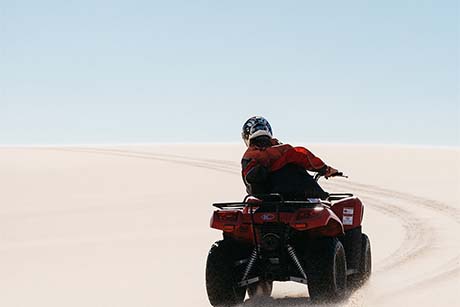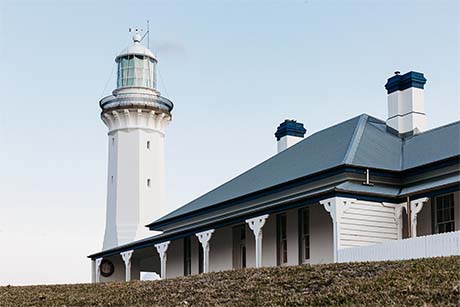30 October 2023
![]() 8 mins Read
8 mins Read

The whales have the same idea as us, only this time of year they’re doing the NSW coast in the other direction. Gazing out to sea from a headland at Cabarita Beach, Tweed Heads, there’s no end to bushy plumes of blow and flashes of surfacing bulk as humpback whales migrate north for winter.
No matter the direction you head, a coastal NSW road trip offers up a mash-up of the usual and the unusual, the breathtaking and the awe inspiring, and whatever takes your fancy. The 1000 or so kilometres between Tweed Heads at the Queensland border and deep south Eden burst with options and surprises.
The first surprise: Tweed Heads has (virtually) guaranteed snorkelling with green sea turtles. Tiny, craggy Cook Island, a quick boat trip just 600 metres offshore, is a year-round feeding ground. Jumping in reveals an instant wonderland of puffer fish, clownfish, a wobbegong and squadrons of translucent squid. Oh, and turtles – at least four (a quiet day), flapping like winged dishes along a rocky reef floor three metres below.
But perhaps you’d prefer picnicking with whales. Gamboling just behind the surf, humpbacks seem almost part of the scrumptious spread (chia puddings, sourdough bread etc.) that Blue Ginger Picnics have arranged on a shady dune at pristine Kingscliff Beach.

Yamba ocean pool at Main Beach
Photo: Brook James
Hard as it is to leave Halcyon House, it is time to hit the road. Rising phoenix-like from a former Cabarita surf motel, the five-star Halcyon is impossibly stylish without uniform style – here some Hamptons flourishes, there some Spanish arches – happily mixing whatever feels right.
Postcard-perfect, almost-unoccupied beaches continue all the way south, as clifftop views of curling white-sand panoramas from Pat Morton Lookout (Lennox Head) and Goanna Headland (Evans Head) attest, until we arrive into Yamba.
Some 180 kilometres from Tweed, this laid-back town ticks the usual coastal getaway boxes: beaches, rock baths, seaside walks, surfing, boating, and seafood to undertake a road trip for – the prawns are famous in these parts. But less-obvious charms include Indian Fusion Tapas Bar
& Restaurant, where the distinctly fusion-inspired lamb shank (not diced as usual) rogan josh is just one signature dish.
On the drive from Yamba to Port Macquarie, another 300 kilometres (three hours)
south, we stop for mid-morning coffee at Beachstone Cafe, near Coffs Harbour, before arriving into town at noon.
The beaches of Port (as locals call it) feature dramatic rock outcrops – and, in one case, camels. Looking bemused as they sit patiently on Lighthouse Beach, tan coats harmonising with the sand, four ships of the desert make the cobalt waters of the Pacific look like an uber-oasis.
Camel personalities vary, says cameleer John Hardy, but this lot all seem pretty zen. Indeed, bobbing gently alongside pounding surf as my camel soft-shoes the sand feels almost meditative.
After a lunch of local fare at LV’s on Clarence, a popular riverside cafe supplied by its own farm, Port’s Glasshouse Regional Gallery inspires another kind of introspection, showcasing local artists and focusing on landscapes and abstracts.
Down the map another 220 kilometres, Port Stephens is Sydney Harbour’s bigger, wilder and relatively unpopulated cousin. After grabbing lunch at Little Nel in Nelson Bay, we head to the imposing Tomaree Head.
Rising 161 metres at the harbour mouth this is the best local bushwalk, passing Second World War gun emplacements up to breathtaking bay and beach views – and on the ocean-side distant Port Stephens Lighthouse (1862) at the far tip of a sand spit. Sharing (and completing) the spectacle five white-bellied sea eagles soar on air currents, high above the isthmus between harbour and ocean.

Quad biking on the sandhills at Worimi Conservation Lands between Newcastle and Port Stephens
Photo: Brook James
Heading off early towards Newcastle allows for ample time in the Worimi Conservation Lands. This 25-kilometre stretch is our hemisphere’s largest sand dune ecosystem, and its Indigenous custodians add pep to their cultural tours with high-adrenaline quad-biking.
Rumbling down a sandy track towards endless undulating dunes and a distant sea, we follow our guide, Josh, in single file. Starting slow, we’re soon roaring and zipping along at up to 70 kilometres an hour.
“Keep the wheels nice and straight, and don’t brake – give it a touch of accelerator,” Josh advises atop a mountainous dune. Suddenly I’m on a self-drive rollercoaster – the dauntingly steep summit, the heart-in-mouth crossing of the edge and then the wild exhilaration of zooming downwards.
Departing Sydney for the Shoalhaven region, we overnight at Culburra Beach; allow a good five to six hours’ leisurely driving for this stretch, including coffee breaks.
One hour down the road, Jervis Bay Stand Up Paddle at Huskisson is another winning combination of Aboriginal culture and outdoor action. Peace reigns as we progress down Currambene Creek to the bay delta, a three-kilometre return trip. Stingrays glide beneath us in waist-deep water; a pelican croaks softly as we pass thick mangroves. Our guides make an effective double act: Mason is a skilful and patient SUP coach, while Ray is a font of Indigenous wisdom, revealing the wide uses of local plants while giving insight into what connection with country means.
After SUP, it’s time to sip; Cupitt just outside Ulladulla solves that. The bucolic hilltop setting belies the energy and enterprise of the Cupitt family who built this buzzing winery-restaurant-fromagerie out of almost nothing. Starting with just a 19th-century cowshed – now the cellar-door – they’ve created a gastronomic idyll with an unwavering focus on recycling and sustainability.

Green Cape Lightstation Keepers’ Cottages
Photo: Brook James
It’s becoming obvious that the Sapphire Coast, as the south is known, is a little more laid-back than the north.
Heading out from Tilba Lake Camp, we pass through Bermagui, taking in Fisherman’s Wharf and its Blue Pool, before arriving into Tathra. The soul of this sleepy, beachy town might be found lounging on the deck of its 1862 timber sea wharf, the last left in NSW. Or it might be pushing pedals on the acclaimed mountain-bike trails behind the town. But if strenuous feels superfluous, there’s always the option of just enjoying the rocky headlands and turquoise-sea beaches.
Onwards to Eden, an ex-whaling town fringed by coastal Ben Boyd National Park, 10,000 hectares of preserved bush ironically named for a colonial speculator who sought to develop the area commercially. At the southern end, on a lonely jut of reddish rocky headland, Green Cape lighthouse (1883) offers accommodation in the keepers’ cottages, perched on the sea cliff above churning breakers and a wide, empty ocean.
On the other side of Eden at Pambula, the Captain Sponge’s Magical Oyster Tour tells of a key local industry.
As Sponge’s boat tours his leases on the Pambula River –home to Sydney rock and angasi oysters – he entertains with oyster husbandry information, shows how to shuck like a pro and presents a delicious sample.
Extensive waterside Aboriginal middens show this waterway has enjoyed continuous use since before recorded time. Given what we have experienced over the last week, it seems unlikely we’ll ever record a time when people aren’t out enjoying the NSW coast.
LEAVE YOUR COMMENT